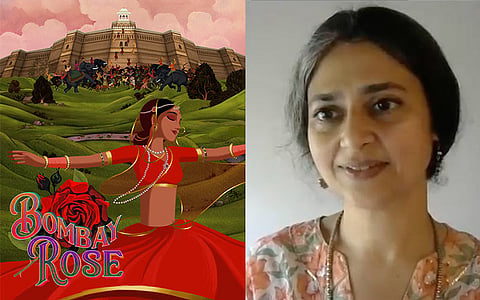
- Reviews
- Power List 2024
- Cannes 2024
- In-Depth Stories
- Web Stories
- News
- FC Lists
- Interviews
- Features
- FC SpecialsFC Specials

Filmmaker Gitanjali Rao's award-winning debut feature Bombay Rose has finally made its way to a streaming platform after making waves across the global festival circuit. The film, which opened the 34th Venice International Film Critics' Week, the second Indian film to ever do so, is now streaming on Netflix. Ahead of the film's streaming release, the celebrated animation filmmaker speaks to Baradwaj Rangan about the painstaking 18-month process of bringing the film to life.
Edited Excerpts:
Let's talk about the creation of animation itself. Can you take us through the process of how it comes together piece by piece, layer by layer?
Gitanjali Rao: Yeah sure. It seems like magic at times when you see the finished product, but I can deconstruct it for you to a certain extent. For Bombay Rose, the way Paper Boat Animation Studios deconstructed my style of animation was amazing. The way we worked definitely wasn't the norm, it was us searching for a solution.
How I usually create my animation films is I do them alone and single-handedly paint them frame by frame. I paint a background, a foreground, a character and someone walking in front of the screen. All of this is painted on one frame, and then for the next frame I move that character, and the background and everything else. Now when this has to be done by a group of people, you can't do it that way because one single mind is not controlling it. So, what was so beautiful with Paper Boat Studios is working with them to come up with an approach where it looks like it's the same person who has animated the entire project.
There are people who can do wonderful animation but they can only do it in line drawing, and then there are people who can do beautiful colour painting but they might have no knowledge of animation. We needed both, so, the way we did it was we had a bunch of very senior animators who did the line drawing of the entire project on softwares like Flash and Photoshop. These line drawings were given to a bunch of young artists freshly graduated from art schools, who did not really know animation, but they knew colouring and painting.
But then between these line drawings and the colouring, there seemed to be a gap in not being able to understand where the light and shadows come in. So, we got a different group of animators who took these drawings and simply focused on the light and shades of grey, after which it was given to the colouring artists who'd use Photoshop and paint frame by frame.
That's amazing, thank you for taking us through this process. What people typically think animation is, is that you draw a frame and the next frame so that it moves a little, and so on. This is so much more complicated that that, you are talking about light and shadow and the technical texture and how the light and rain falls, it's just mind blowing.
Gitanjali Rao: Yeah and we do also have separate departments that fulfil the roles like you have in live-action. We have a pre-production department who is doing the background work of the film, then somebody designing the layouts of the film – which is exactly which camera angle is looking at the background, because when the angles change the drawings have to change.
In Disney and Pixar projects, you have at least 30 or 40 people working the pre-production. I had 3 people bringing together my vision. And it's not like live action where pre-production ends then post production starts. In animation it's a very continuous process. When you do 18 months on a film, you are doing pre-production for 16 months and the animation for 18 months and compositing for the 21 months because it's still not over.